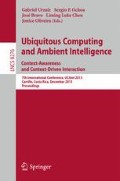Abstract
When talking about energy efficiency at global scale, buildings are the cornerstone in terms of power consumption and CO2 emissions. New communication paradigms, such as Internet of Things, can improve the way sensors and actuators are accessed in smart buildings. Following this approach, we present an energy efficiency subsystem integrated with a building automation solution that makes the most of the energy consumed, considering user preferences, environmental conditions, and presence/identity of occupants. Through a three-stage approach based on behavior-centred mechanisms, the system is able to propose concrete settings on building devices to cope with energy and user comfort restrictions. The proposal has been implemented and deployed on a smart building. A set of tests validates the system when users are correctly located and identified at comfort service points, and first experimental stages already reflect energy saves in heating and cooling about 20%.
Access this chapter
Tax calculation will be finalised at checkout
Purchases are for personal use only
Preview
Unable to display preview. Download preview PDF.
References
Atzori, L., Iera, A., Morabito, G.: The internet of things: A survey. Computer Networks 54(15), 2787–2805 (2010)
Stunder, M.J., Sebastian, P., Chube, B.A., Koontz, M.D.: Integration of real-time data into building automation systems (No. DOE/OR22674/611-30050-01). Air-Conditioning and Refrigeration Technology Institute, US (2003)
Han, D., Lim, J.: Design and implementation of smart home energy management systems based on ZigBee. IEEE Transactions on Consumer Electronics 56, 1417–1425 (2010)
Oksa, P., Soini, M., Sydänheimo, L., Kivikoski, M.: Kilavi platform for wireless building automation. Energy and Buildings 40(9), 1721–1730 (2008)
Morrissey, E., O’Donnell, J., Keane, M., Bazjanac, V.: Specification and implementation of IFC based performance metrics to support building life cycle assessment of hybrid energy systems (2004)
Escrivá-Escrivá, G., Álvarez-Bel, C., Peñalvo-López, E.: New indices to assess building energy efficiency at the use stage. Energy and Buildings 43(2), 476–484 (2011)
Handbook, A. S. H. R. A. E.: Fundamentals. American Society of Heating, Refrigerating and Air Conditioning Engineers, Atlanta (2001)
Zamora-Izquierdo, M.A., Santa, J., Gómez-Skarmeta, A.F.: An Integral and Networked Home Automation Solution for Indoor Ambient Intelligence. IEEE Pervasive Computing 9, 66–77 (2010)
Centre Europeen de Normalisation: Indoor Environmental Input Parameters for Design and Assesment of Energy Performance of Buildings - Addressing Indoor Air Quality, Thermal Environment, Lighting and Acoustics. EN 15251 (2006)
Berglund, L.: Mathematical models for predicting the thermal comfort response of building occupants. ASHRAE Transactions 84(1), 1848–1858 (1978)
Callaghan, V., et al.: Inhabited intelligent environments. BT Technology Journal 22(3), 233–247 (2004)
Moreno-Cano, M.V., Zamora-Izquierdo, M.A., Santa, J., Skarmeta, A.F.: An indoor localization system based on artificial neural networks and particle filters applied to intelligent buildings. Neurocomputing (2013)
Author information
Authors and Affiliations
Editor information
Editors and Affiliations
Rights and permissions
Copyright information
© 2013 Springer International Publishing Switzerland
About this paper
Cite this paper
Moreno Cano, M.V., Santa, J., Zamora, M.A., Skarmeta Gómez, A.F. (2013). Context-Aware Energy Efficiency in Smart Buildings. In: Urzaiz, G., Ochoa, S.F., Bravo, J., Chen, L.L., Oliveira, J. (eds) Ubiquitous Computing and Ambient Intelligence. Context-Awareness and Context-Driven Interaction. Lecture Notes in Computer Science, vol 8276. Springer, Cham. https://doi.org/10.1007/978-3-319-03176-7_1
Download citation
DOI: https://doi.org/10.1007/978-3-319-03176-7_1
Publisher Name: Springer, Cham
Print ISBN: 978-3-319-03175-0
Online ISBN: 978-3-319-03176-7
eBook Packages: Computer ScienceComputer Science (R0)

